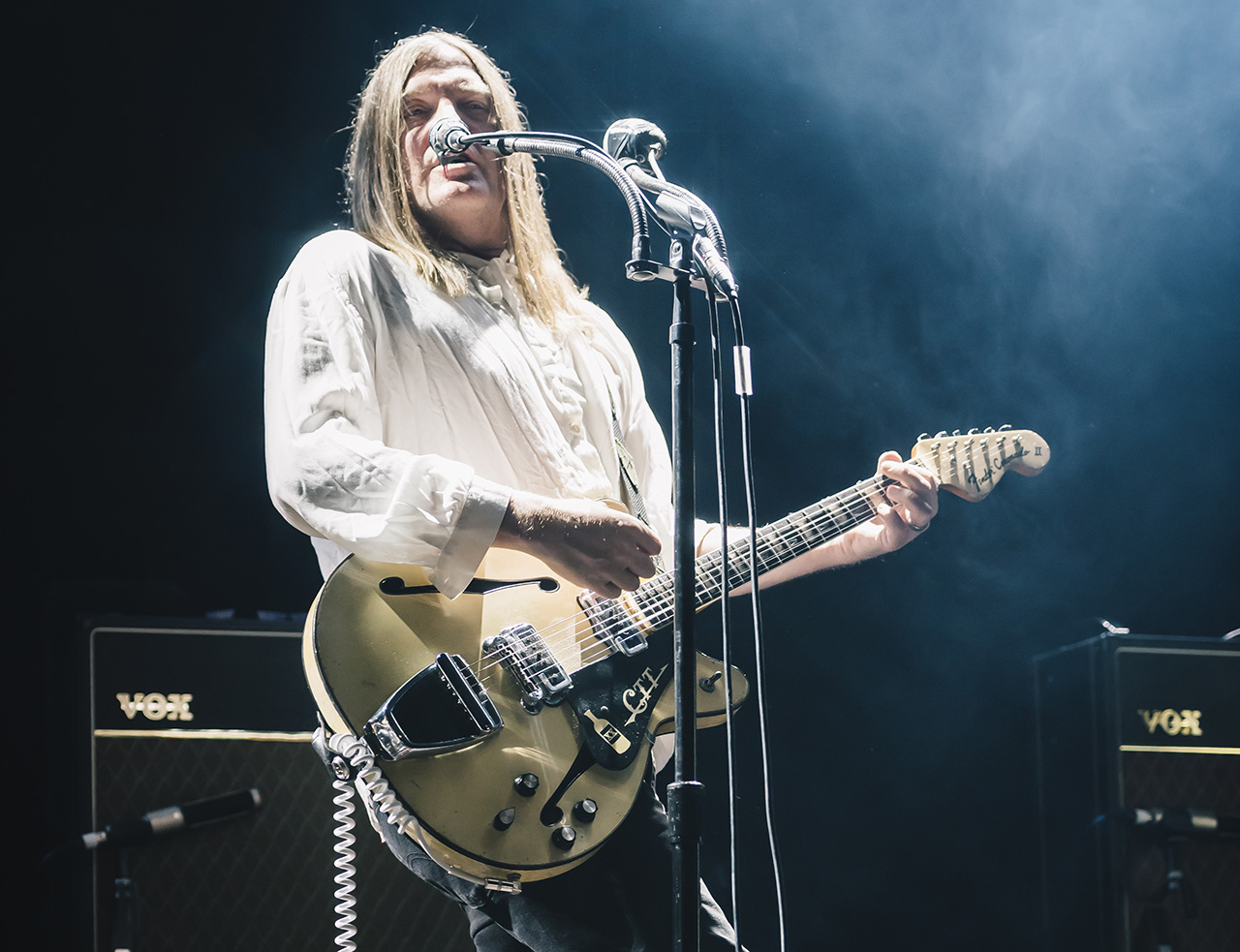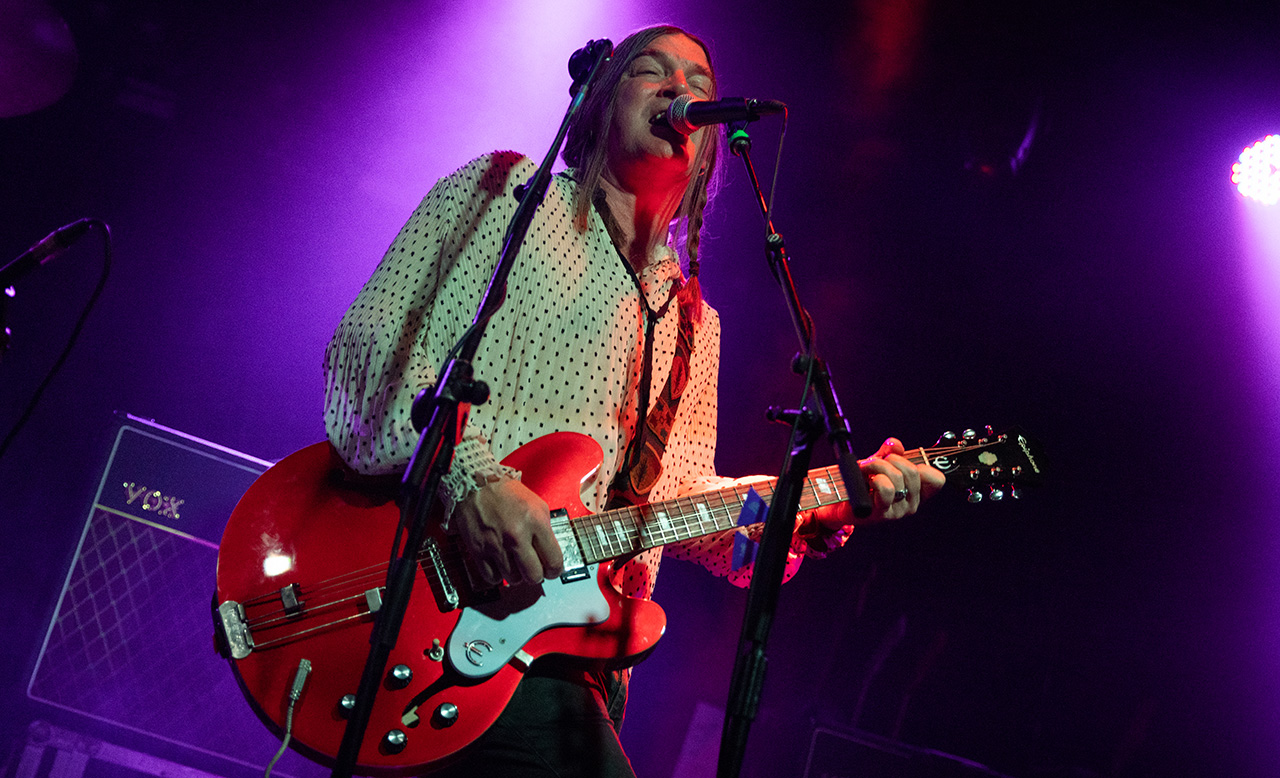“Where’s the noise? Where is the ugliness that we find compelling in beauty?” The Dandy Warhols’ Peter Holmström and Courtney Taylor-Taylor on their struggles with the wrong guitars and boring amps, and how they collaborated with Slash
With influences ranging from Pantera and Black Sabbath to Bauhaus, an ever-changing pedal chain, and a mission statement that’s never changed, the Dandy Warhols are still – 30 years into their career – keeping it weird

Are they alt-rock? Power pop? Shoegaze? Garage rock? The Dandy Warhols – lynchpinned by guitar duo Peter Holmström and Courtney Taylor-Taylor – are probably all of the above, and more.
The best-known work by the Portland, Oregon-formed group include 1995’s Dandys Rule OK and 1997’s The Dandy Warhols Come Down. But Holmström and Taylor-Taylor also dig their ‘00s stuff, Thirteen Tales from Urban Bohemia (2000) and Earth to the Dandy Warhols (2008).
Together with bassist Zia McCabe and drummer Brent DeBoer, they’re still at it, as 2024 record Rockmaker proves. The sounds they create run the gamut of Love and Rockets, Christian Death and The Yardbirds.
“The hard thing about being in this band is we’re all super uptight about sounding like we’re imitating something that we’re not,” Taylor-Taylor says. “Obviously, imitation is a wonderful exploration. But for us, it has to be something that hasn’t been imitated lately.”
“I like sounds that are kind of happy accidents,” Holmström adds, “and just being fascinated by, ‘What does this do? And if I do it more than once, what does that create?’”
Taylor-Taylor agrees: “That’s another part of the weirdness and the noise. The difference is really how much ugliness is in your beauty. I think we’re gonna keep coming back to that as a theme.”
How do you two view guitars within The Dandy Warhols’ music?
All the latest guitar news, interviews, lessons, reviews, deals and more, direct to your inbox!
Holmström: “I was never a bedroom shredder. When I was growing up, it was more about playing chords and making sounds. And once I heard My Bloody Valentine, all I wanted to do was make noise and textures.
“So it’s been that sort of approach, more than fancy leads and that kind of thing. It’s lots of pedals and just seeing how extreme you can get with the different varieties of sounds.”

Taylor-Taylor: “I was the drummer for every band I was in until this one. Pete kind of talked me into doing this because I’d been writing songs and recording stuff since I was about 15 or 16.
“When my high school band broke up, I realized the trick as a songwriter was the thing you can’t find, so I started writing songs. I got a four-track cassette, a mic and a delay pedal.
With riffs, everything goes in there – there’s some Black Sabbath inspiration, Love and Rockets and Bauhaus
Peter Holmström
“My Kung Fu instructor said he wanted me to teach him drums – and gave me his guitar in exchange for lessons. Being in bands with guitar players showed me the basic chords. I knew just enough chords to groove for four and a half minutes, which is songwriting for me. The guitar has been the most effective tool to get the job done.”
The guitars in The Dandy Warhols have always been pretty interesting.
Taylor-Taylor: “Well, you try to push the sound of the guitar – everybody who’s any good always has. Jimi Hendrix cut his speakers, and everybody was pushing the electronic side of it. It’s like motor cars: who could go faster and push the limits of sensibility?

“So guitars are a tool to help my minimalist approach to songwriting. You experiment sonically, because it requires some noise to make the chords emotional or powerful. There has to be some kind of screwball – I don’t enjoy the sound of a perfectly tuned grand piano.
“In nightclubs I’ve heard a lot of random music. I learned what I didn’t like, and I knew I didn’t like pure, perfect, and professional sounds.”
What sort of sounds have inspired you lately?
Taylor-Taylor: “Pete, for three new distortion pedals!”
Holmström: “That happens every year! But that’s not really what inspired this. The idea was mainly that the songs were all going to start with a riff of a heavier nature than what we’ve done in the past.
“Distortion and fuzz pedals come into that, and there were certainly a few on this record that were key to its sounds. The Gamechanger Audio Plasma [high-voltage distortion pedal] being one of them. Then there’s a company in New Zealand called firehorsefx. The owner sent me a Fiery Red Horse Fuzz pedal that’s amazing.

“Those were sort of key to the sound, at least on my side. But with riffs, everything goes in there – there’s some Black Sabbath inspiration, and Love and Rockets, Bauhaus, that kind of thing.”
Taylor-Taylor: “Christian Death. The Cross sounds like Christian Death!”
Holmström: “What else? I made a Pantera kind of attempt.”
Taylor-Taylor: “Yeah, I love that… the Pantera track, Real People, or whatever I ended up calling it.”
Holmström: “There’s The Damned, of course. The track Root of All Evil was inspired by The Yardbirds’ Train Kept-A Rollin.’”
I don’t really care what guitars I play in the studio. I care a lot live – I had to learn to care
Courtney Taylor-Taylor
Taylor-Taylor: “That was cool because – we realized it reminded us of when Sly and the Family Stone found metal guitar in the ‘70s. We had a day of revisiting all that and just having our minds blown. Then it became like funk-metal. Fortunately, it didn't turn out like rap-rock-funk, like the ‘80s or ‘90s kind of stuff!”
What amps do you lean on while recording?
Holmström: “I have a fucked-up Fender Twin from the ‘70s that’s going to die any day! It’s nothing special – it’s one of the master volume ones, and I recently discovered that only one speaker is working. But I get my more extreme sounds out of that. It’s always interesting, no matter what you do.”

And how about guitars?
Holmström: “I use Saul Koll’s Willcutt Guitars mostly, and like Fender Jazzmasters or Jaguars to get more single-coil tones, and a six-string bass. That’s pretty much it these days.”
Taylor-Taylor: “I don’t really care what I play in the studio. I care a lot live – I had to learn to care because we just did a tour of Australia with the Hoodoo Gurus. Those guys are killer and their guitar tones are sick. They just rip – it’s like that ‘80s, new wave, rockabilly kind of stuff; and beautiful melodies.
“I had a couple of borrowed guitars: a Gretsch Country Gent and a Gibson ES-335. Neither one was great – oh my God, there’s your noise problem. Like, ‘Where’s the noise? Where is the ugliness that we find compelling in beauty?’ It was really hard playing them. And I rented a different amp every day.”
Holmström: “We might have had the same amps, but it didn't matter. It was the newer Vox AC30s, which sound good… but they’re not interesting.”

Taylor-Taylor: “I probably should have cut the speakers and just paid for them at the end of the tour. I usually have to haul my damn Supro Coronados. I’ve got a matched set of ’67 Coronados in the same color. They're just so cool.
“I like just turning around, and if Pete says to play something, I grab whatever’s there. We have a lot of instruments and we have our own studio as a base, so I’m used to saying, ‘Give me a guitar. Is it in the right tuning?’ That’s pretty much the only question!”
You worked with Slash on I’d Like To Help You With Your Problem. How did that go down?
At some point this summer, I will work on a very long remix that includes every single thing Slash recorded
Courtney Taylor-Taylor
Taylor-Taylor: “It seems when dealing with people at the ‘all-time greatest American rock icons’ level, you just have your people get a hold of their people. But it was pretty cool because our manager sent over our rough mix, and we got a response within about 45 minutes that he loved it and wanted to play on it.
“It was all very modern and digital – our engineer sent his engineer the digital files, and a few weeks later, he sent back the files including the tracks he’d laid down. At this point, there were a lot more tracks than we could use in one version of the song. That got sent to the mixer, who set the levels and panning and wove them in and out around the vocals.
“At some point this summer, I will work on a very long remix that includes every single thing he recorded.”

Slash aside, of the 11 songs on Rockmaker, which represent you both as guitarists?
Holmström: “I think this might be my favorite thing I’ve ever recorded – and it’s the last minute and a half of the record! It's this Schumann PLL clone and the sound of dying out slowly and becoming more and more weirdly pixelated.
“I was super fascinated by that. I recorded it three times and I have them panning differently, and you get this weird little sound that almost sounds like a synth. Then it becomes super granular and weird and becomes a series of clicks.
“That pretty much encapsulates what I’m all about. I mean, there are other things on the record that I’m super proud of, but that’s my perfect little moment.”
Taylor-Taylor: “For me it’s Danzig with Myself. That sludge riff represents me as a guitar player on this record. It’s a simple four-chord thing, turned around backward and slowed down. It’s so simple and repetitive, and it never stops for the entire song.”
I think this might be my favorite thing I’ve ever recorded – and it’s the last minute and a half of the record!
Peter Holmström
Looking back on The Dandy Warhols records, which one means the most to you?
Taylor-Taylor: “Earth to the Dandy Warhols. For me, it’s the most perfect sonically – I’ve never stuck it in any stereo anywhere and gone, ‘Oh, God, what in the hell?’ Every other record has sonic issues. That one has none. It’s the most technically perfect as far as weird stereo problems or low-end problems.”
Holmström: “I don’t know if one record is better than any other for me. It’s more about the experience of recording and making the record than the actual finished product.
“I always go back to Thirteen Tales from Urban Bohemia because it was the last record we did in the old style, where you learn a bunch of songs and then go to a studio.
“It really has this sort of innocence before the world changed from tape to ProTools. And it was an intense process because we did it over a month. Now, we stretch things out over years!”
- Rockmaker is out now.
Andrew Daly is an iced-coffee-addicted, oddball Telecaster-playing, alfredo pasta-loving journalist from Long Island, NY, who, in addition to being a contributing writer for Guitar World, scribes for Bass Player, Guitar Player, Guitarist, and MusicRadar. Andrew has interviewed favorites like Ace Frehley, Johnny Marr, Vito Bratta, Bruce Kulick, Joe Perry, Brad Whitford, Tom Morello, Rich Robinson, and Paul Stanley, while his all-time favorite (rhythm player), Keith Richards, continues to elude him.

